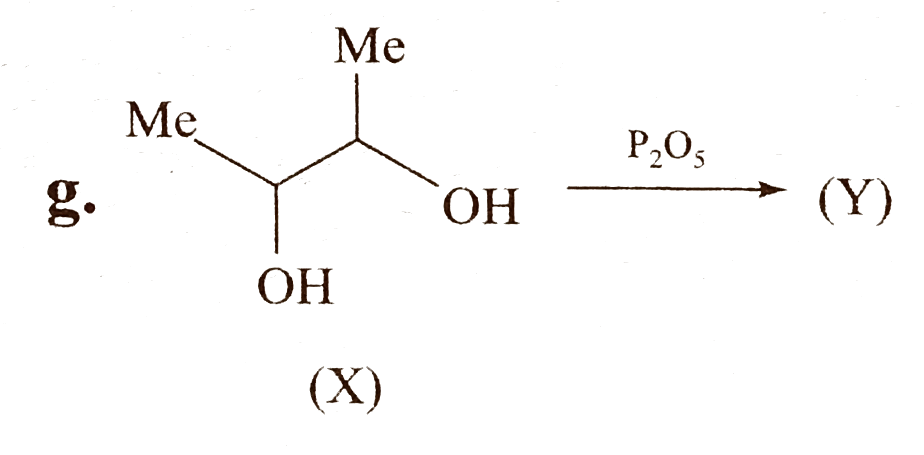Explain the formation of (A) and (B) in the following reaction.
Oct−1−eneNBS+CCI4−−−−−−−→hv(A)(80%)+(B)(20%)
C5H11−CH=CH2NBS/CCI−−−−−−→
C5H11−CH(Br)−CH3−Bromo−1−octane(20%)=CH2+C5+C5H11CH=CH−CH2Br1−Bromo−2−octene(80%)
[C5H11.CH−CH=CH2↔C5H11CH=CH−.CH2]
The major brominated product results from the introduction of Br on methylene C, so as to get more − substituted brominated alkene. The shift of the double bond is an example of allylic rearrangement.
Topper's Solved these Questions
- ALKENES AND ALKADIENESBook:CENGAGE CHEMISTRYChapter:ALKENES AND ALKADIENESExercise:EXERCISES
Explore 29 Videos
- ALKENES AND ALKADIENESBook:CENGAGE CHEMISTRYChapter:ALKENES AND ALKADIENESExercise:linked Comprehension Type
Explore 38 Videos
- ALKENES AND ALKADIENESBook:CENGAGE CHEMISTRYChapter:ALKENES AND ALKADIENESExercise:Single correct Answer
Explore 14 Videos
- ALKANES AND CYCLOALKANESBook:CENGAGE CHEMISTRYChapter:ALKANES AND CYCLOALKANESExercise:Archives
Explore 13 Videos
- ALKYNESBook:CENGAGE CHEMISTRYChapter:ALKYNESExercise:Exercises (Archives - Analytical and Desriptive Type)
Explore 4 Videos
Similar Questions
Give the number of stereoismoers of (A) in the following reactions.
a. (A)(C7H12)O3/oxid.−−−−−→Acetone(B)+Oxalicacid(C)+Aceticacid(D)
b. (A)(C8H14)O3/oxid.−−−−−→Butane−2−ene(B)+Oxalicacid(C)+Aceticacid(D)
c. (A)(C6H10)O3/oxid.−−−−−→Oxalicacid(B)+Aceticacid(C)
d. (A)(C9H16)O3/oxid.−−−−−→Butane−2−one(B)+Pyruvicacid(C)+Aceticacid(D)
e. (A)(C10H18)O3/oxid.−−−−−→Butane−2−one(B)+Pyruvicacid(C)+Propanoicacid(D)
View SolutionCompelte the following reactions by identifying B and C: (ii) CH3−CH3∣C∣CH3−C∣∣O−CH3+NaOH→B+C.
View Solution
Knowledge Check
In the following sequence of reaction, the end product is :
HC≡CHHg2+/H2SO4−−−−−−−−→(A)CH3MgX−−−−−→[H2O](B)[O]−−→(C)Aacetic acidBisopropyl alcoholCacetoneDethanolThe compound (C) in the following series of reactions is:
Acetone + CH3MgBrDry ether−−−−−→AH3O+−−−→B363K−−−−−−−→20% H2SO4C+H2OA2-methylpropeneBbut-2-eneCbut-1-eneDpropeneWhat is the final product of the following reaction sequence?
cyclohexanol overset((i) conc. H_2 SO_4//Delta ) overset((ii) NB S//C Cl_4 //hv)underset((iv) Br_2//40^@ C) underset((iii) Alc KOH//Delta ) toA B
B C
C D
D
Complete the given reaction of alkene with KMnO4 in different conditions
(i) CH3−CH2−C∣CH3=CH22-Methylbut-1-eneAlkalineKMnO4−−−−−−−−−→273K?
(i) CH3−CH2−C∣CH3=CH22-Methylbut-1-eneAcidifiedKMnO4−−−−−−−−−→Δ?
View SolutionComplete the following reactions :
(a) (A)i−BuBr1.Li−−−→2.CuI(B)Ph−O∣∣C−Cl−−−−−−→(C)
(b)
( c)
(d)
( e) .
.
View SolutionComplete the following reactions :
a.
b.
c.
d.
e.
f.
g. ltbr h.
ltbr h. 
i.
j.
k.CH2=C=CH2(A)KNH2−−−−→orC2H5ONa+C2H5OH(B)
View SolutionCH3COOHNaOH−−−→[A]NaOH−−−→CaO[B]Br2−−→hv[C]
View SolutionIn the following reactions . ltb rgt CH3−CH3∣CH−C∣OHH−CH3H+/heat−−−−−→A[Majorproduct]+B[Minorproduct]
(ii) AHBr, dark−−−−−−−−−−−−→in absence of peroxideC[Mejorproduct]+D[Minorproduct]
The major products A and C are repectively
View Solution

